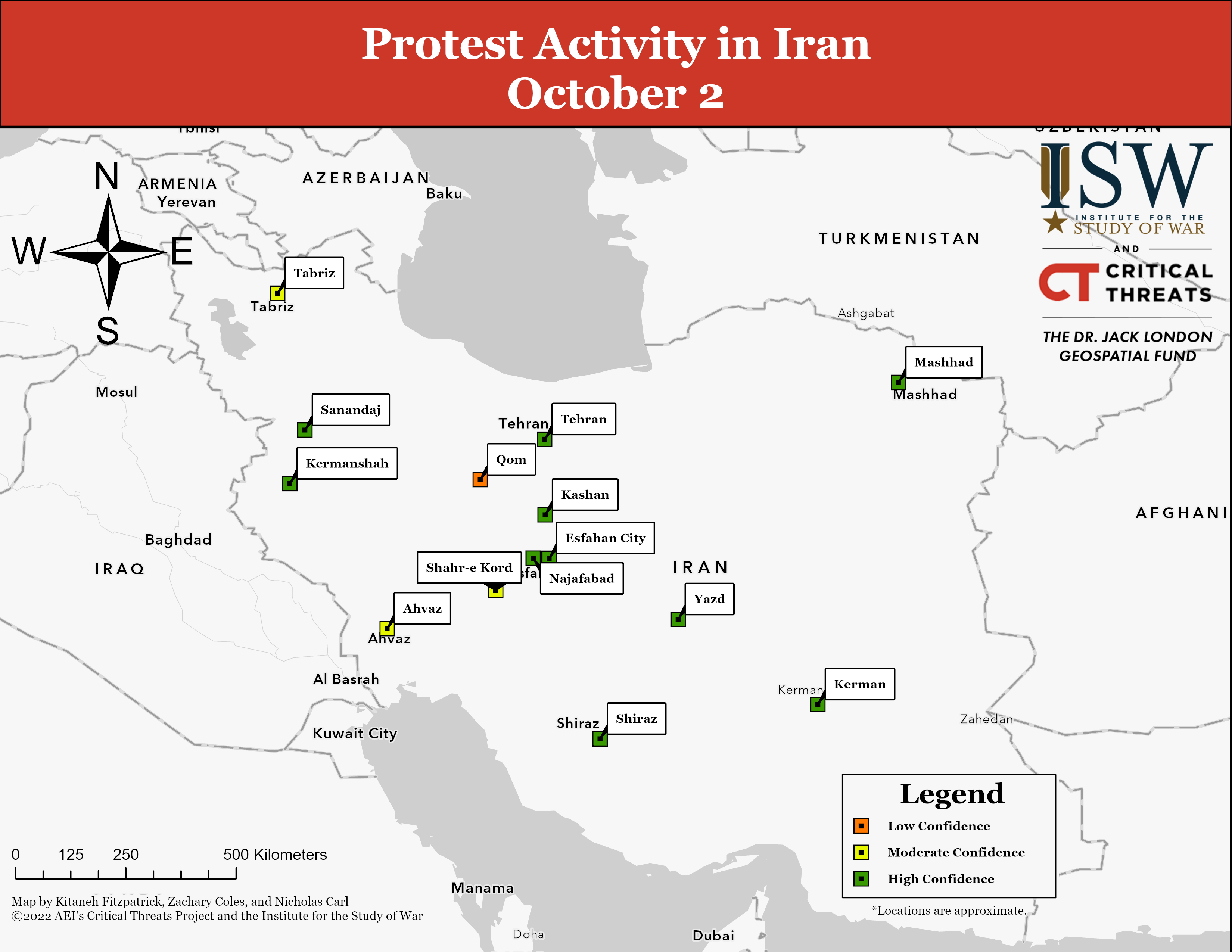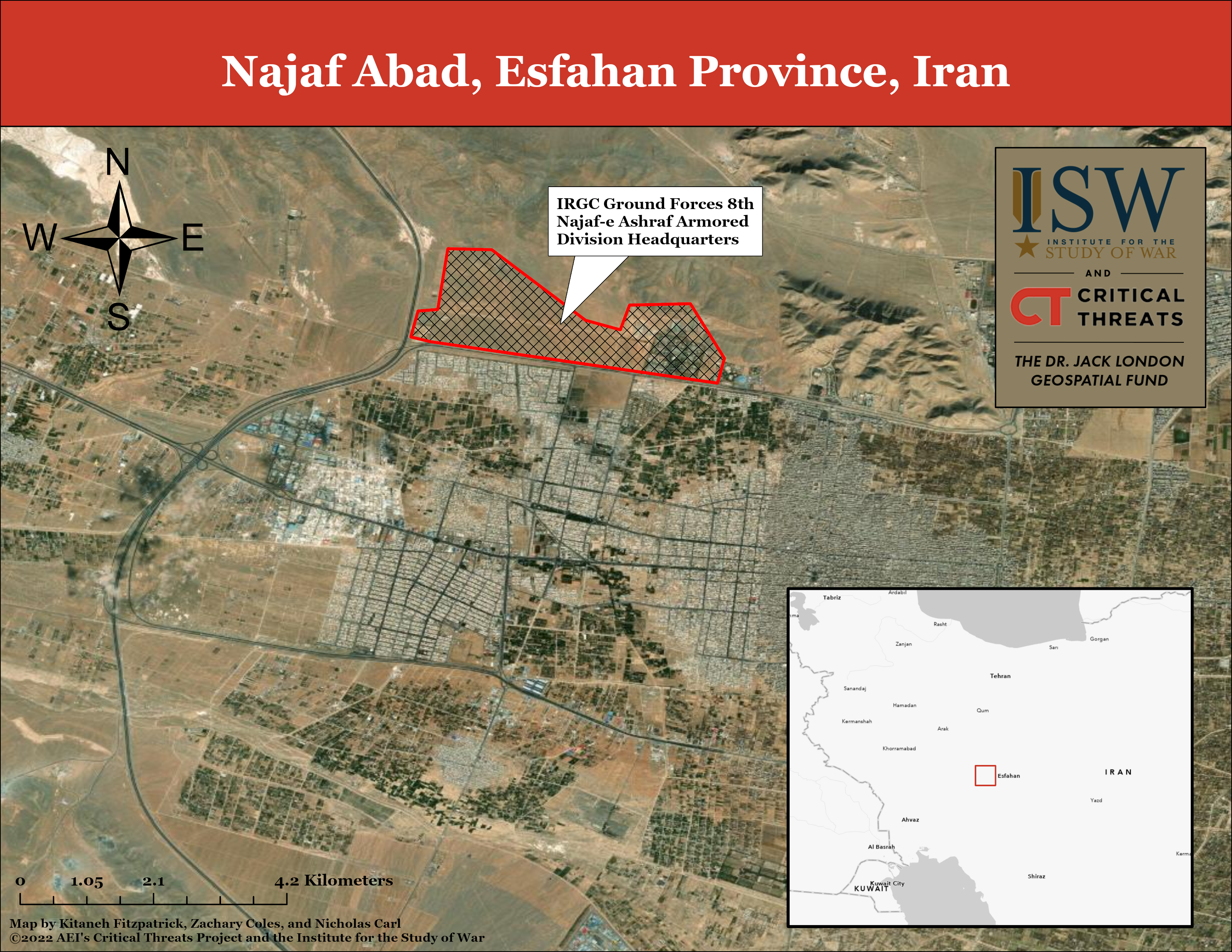Nicholas Carl, Kitaneh Fitzpatrick, Zachary Coles, and Frederick W. Kagan
October 2, 5:00 pm ET
The Iran Crisis Updates are produced by the Critical Threats Project (CTP) at the American Enterprise Institute with support from the Institute for the Study of War (ISW).
The continued public absence of Supreme Leader Ali Khamenei may be hindering regime officials’ efforts to develop a coherent response to the ongoing, anti-regime protests. Khamenei has not addressed the protests nor made a public appearance since September 21, possibly due to his reportedly worsening health.[1] An unidentified Iranian official told Reuters that intra-regime disagreements over supreme leader succession and protest management are dividing the regime elite.[2] This division suggests that Khamenei is not playing his usual role of cohering the regime during a crisis.
Khamenei’s silence may have opened a leadership vacuum that other regime authorities are having to fill. Islamic Revolutionary Guards Corps (IRGC) leaders struck a more conciliatory tone on October 2 as university students have adopted an increasingly prominent role in the protest movement. IRGC Commander Major General Hossein Salami said, “we consider [the protesting youth] our friends, and we will not allow the enemy to attack you.”[3] Salami was referring to his allegation that Iran’s international adversaries are coopting and stoking the protests to destabilize the regime. Armed Forces General Staff (AFGS) Chief Major General Mohammad Bagheri met with students and celebrated their role in advancing the regime and revolution.[4] Khamenei would ordinarily play a prominent role in such messaging during a crisis, and his silence is abnormal.
President Ebrahim Raisi has played a minor role thus far in communicating to the protesters or the Iranian population. His low profile is remarkable given his legal responsibilities for maintaining public order in Iran. He may seek to avoid becoming the face of the crackdown to preserve his chances to be accepted as the next supreme leader, but it is hard to see his relative silence as anything other than weakness.
Anti-regime outlet IranWire has published reports claiming that security leaders have disagreed over how to respond to the protests, further indicating that they may lack guidance from the supreme leader. IranWire reported on September 24 that IRGC leaders accused other security bodies suppressing protests of negligence, citing an unidentified former Iranian official.[5] IranWire also reported on September 29 that senior IRGC officers have disagreed with the brutal treatment of protesters and instead advocated for fighting anti-regime Kurdish groups in northwestern Iran.[6] CTP cannot verify these reports.
Khamenei’s absence may be emboldening segments of the clerical establishment, especially in Qom, to criticize and pressure the regime more openly. Two senior clerics—Ayatollah Mustafa Mohaghegh Damad and Ayatollah Asadollah Bayat Zanjani—issued statements on September 17, criticizing state security services for the death of Mahsa Amini.[7] Ayatollah Hossein Nouri Hamedani called on the regime to listen to the people’s grievances on September 25.[8] Persian-language media outlet Zeitoon published a statement allegedly from students and teachers at the Tehran, Mashhad, and Qom seminaries on September 30, condemning Khamenei and the regime crackdown on the protests.[9]
Key Takeaways
- Supreme Leader Ali Khamenei remains absent and did not make a public appearance or statement.
- Anti-regime protests decreased in number across Iran but were significantly more violent in Tehran.
- Social media rumors claimed that state security services are facing significant bandwidth constraints in West Azerbaijan and Kurdistan provinces.
- Iran’s Iraqi proxies are attempting to decouple anti-corruption Tishreen movement protests from Iraqi nationalists’ anti-Iran sentiments.
- Solidarity protests against the Iranian regime spread to Lebanon.
- The IRGC attacked anti-regime Kurdish militia positions in Iraqi Kurdistan for the seventh consecutive day.
Supreme Leader Succession
Supreme Leader Ali Khamenei remains absent and did not make a public appearance or statement on October 2. Persian-language social media account tweeted on October 1 that Khamenei will visit Law Enforcement (LEC) facilities in the coming days. The LEC is Iran’s premier internal security service and police force. The regime has used the LEC extensively throughout Iran to crack down on the ongoing, anti-regime protests.
Anti-Regime Protests
Anti-regime protests decreased in number across Iran but were significantly more violent—specifically in Tehran—on October 2. CTP assesses with moderate-to-high confidence that demonstrations occurred in at least 13 Iranian cities in 10 different provinces. Iranian social media users documented unrest in the following locations, the majority of which occurred on or in the vicinity of university campuses.
- Esfahan City, Esfahan Province
- Najaf Abad, Esfahan Province
- Kashan, Esfahan Province
- Shahr-e Kord, Esfahan Province
- Shiraz, Fars Province
- Kerman City, Kerman Province
- Kermanshah City, Kermanshah Province
- Sanandaj, Kurdistan Province
- Mashhad, Khorasan Razavi Province
- Tehran City, Tehran Province (violence reported)
- Yazd, Yazd Province
- Ahvaz, Khuzestan Province
- Tabriz, East Azerbaijan Province (violence reported)
Regime security forces brutally suppressed anti-regime protests at the Sharif University of Technology in Tehran on October 2. Sharif University students reported that security personnel barricaded, shot, and arrested student protestors.[10] Some social media users reported that Basij members seized students’ cellphones and checked for footage or photographs of protests. Basijis allegedly beat students who possessed documentation of protests on their personal devices.[11] Students were still able to circulate footage of protests—and ensuing violence—to Twitter accounts reporting on ongoing demonstrations.[12] Some Sharif University students called on other local Iranian youth to visit Sharif’s campus in solidarity.[13] Sharif University’s student newspaper was similarly able to report on the regime’s violent protest crackdown on its official Twitter account.[14] Science, Research, and Technology Minister Mohammad Ali Zolfi Gol allegedly visited the Sharif University campus to defuse tensions, likely signaling the gravity of clashes between protestors and security forces.[15] Student protestors reportedly remain unable to leave the university campus at the time of this publication.[16]
Sharif University protests may particularly concern the regime given the importance of the university to the military establishment. Sharif University of Technology has ties to the Iranian armed forces and supports the regime's ballistic missile development. Sharif University has previously supported the Iranian nuclear program and has close ties to the Guards.[17] The US Treasury Department sanctioned Sharif University President Rasoul Jalili in 2012 for his role in supporting human rights abuses, censorship, and terrorism perpetrated by the Iranian government.[18]
Social media rumors claimed that state security services are facing significant bandwidth constraints in West Azerbaijan and Kurdistan provinces. A Persian-language social media account tweeted that the IRGC Ground Forces Hamzeh Seyyed ol Shohada Operational Headquarters has called on local Kurdish militias to secure Baneh, Kurdistan Province and Mahabad, West Azerbaijan Province.[19] The Hamzeh Seyyed ol Shohada Operational Headquarters oversees IRGC activities and security in West Azerbaijan and Kurdistan provinces.[20] The account claimed that the regime’s elite security forces, such as the LEC Special Units, have been deployed to the major cities in West Azerbaijan and Kurdistan provinces, suggesting that these security forces do not have the bandwidth to cover Baneh and Mahabad.
The regime could escalate significantly against the protesters in Najaf Abad if they expand further. The IRGC Ground Forces 8th Najaf-e Ashraf Armored Division is headquartered around the town’s periphery.[21] The IRGC is likely sensitive to instability particularly in Najaf Abad given the location of this armored division‘s headquarters. Najaf Abad is a relatively small town with a population of around 300,000 according to 2016 estimates.[22]
Axis of Resistance and Regional Developments
Iran’s Iraqi proxies are attempting to decouple anti-corruption Tishreen movement protests from Iraqi nationalists’ anti-Iran sentiments. Media channels affiliated with Iranian proxy militias Asaib Ahl al-Haq (AAH) and Kataib Hezbollah (KH) thanked peaceful Tishreen protesters, distinguishing them from the violence perpetrated by Iraqi nationalist Shia cleric Moqtada al-Sadr's followers during the October 1 protests in Baghdad.[23] AAH and KH media channels also claimed that cleavages had emerged between Tishreen protesters and the Sadrists.[24]
AAH, KH, and Lebanese Hezbollah (LH) media channels echoed Iranian regime talking points that downplayed the severity of the protests and blamed Iran’s adversaries. AAH and KH media channels claimed that the US, United Kingdom, and Saudi Arabia instigated and encouraged unfavorable reporting of the protests.[25] Proxy media channels also stressed the protests’ shrinking scale and warned that outside actors seek to divide the Iranian people.[26] LH media outlets repeatedly promoted IRGC Commander Major General Hossein Salami’s September 2 speech that warned the US, United Kingdom, and Saudi Arabia are attempting to deceive Iran’s youth.[27]
Solidarity protests against the Iranian regime spread to Lebanon on October 2.[28] Several dozen women staged a solidarity protest in Beirut and chanted the Arabic translation of the popular Iranian “women, life, freedom” protest slogan.[29]
The IRGC attacked anti-regime Kurdish militia positions in Iraqi Kurdistan for the seventh consecutive day. The IRGC conducted an artillery attack on Sidekan in Soran District, Erbil Province.[30] The IRGC has concentrated attacks on militia positions in Choman District and Soran District since September 26.[31]
[1] https://www.nytimes.com/2022/09/16/world/middleeast/irans-supreme-leader-ayatollah-ali-khamenei-ill.html?smid=nytcore-ios-share&referringSource=articleShare;%20https://www.wsj.com/articles/amid-iran-protests-a-powerful-leader-emerges-from-the-shadows-11664105423
[2] https://www.reuters.com/world/middle-east/iran-leaders-disarray-struggle-close-ranks-over-protests-analysts-official-2022-09-30/
[3] http://www.tasnimnews dot com/fa/news/1401/07/10/2782488
[4] http://www.tasnimnews dot com/fa/news/1401/07/10/2782439
[5] https://iranwire.com/en/iran/107848-iranwire-exclusive-khamenei-may-order-a-massacre/
[6] https://iranwire.com/en/politics/108086-exclusive-irans-security-and-intelligence-officials-fear-mutiny-in-the-ranks/
[7] https://www.radiofarda.com/a/32037877.html
[8] https://www.radiofarda.com/a/nouri-hamedani-urge-government-listen-people/32051386.html
[9] www.zeitoons dot com/105642
[10] https://twitter.com/Sharif__Daily/status/1576590810594041861
[11] https://twitter.com/hediekimiaee/status/1576633338797826050
[12] https://twitter.com/homelander_ir/status/1576621528669913089, https://twitter.com/1500tasvir/status/1576596305152864256
[13] https://twitter.com/Hassanesmaeili8/status/1576580822207180800
[14] https://twitter.com/Sharif__Daily/status/1576590810594041861
[15] https://twitter.com/borzou/status/1576642345663336449
[16] https://twitter.com/iranworkers/status/1576660628315336706
[17] https://www.iranwatch.org/iranian-entities/sharif-university-technology
[18] https://www.state.gov/report-to-congress-list-of-persons-who-are-responsible-for-or-complicit-in-certain-human-rights-abuses-in-iran/
[19] https://twitter.com/goliammar/status/1576517596782157824
[20] https://www.aei.org/wp-content/uploads/2020/01/Irans-Reserve-of-Last-Resort.pdf
[21] https://www.aei.org/wp-content/uploads/2020/01/Irans-Reserve-of-Last-Resort.pdf
[22] http://najafabadnews dot ir/%d8%aa%d9%88%d8%b2%db%8c%d8%b9%d8%aa%d9%88%d8%b2%d9%8a%d8%b9-%d8%ac%d9%85%d8%b9%d9%8a%d8%aa-%d8%b4%d9%87%d8%b1%d8%b3%d8%aa%d8%a7%d9%86/
[23] https://t.me/Tura313/33354
[24] https://t.me/sabreenS1/60711; https://t.me/sabreenS1/60746;
[25] https://www.alahednews dot com dot lb/article.php?id=46379&cid=116
[26] https://t.me/maymun5/9890; https://t.me/maymun5/9867; https://t.me/maymun5/9862
[27] https://www.alahednews dot com dot lb/article.php?id=46379&cid=116
[28] https://www.theatlantic.com/ideas/archive/2022/10/whole-generation-revolts-against-iranian-regime/671631/; https://twitter.com/nafisehkBBC/status/1576651428461887488?s=20&t=ZXywridpI9xx1N4XjcDz3w;
[29] https://today.lorientlejour.com/article/1313370/women-in-beirut-demonstrate-in-solidarity-with-irans-mahsa-amini-protests.html
[30] https://shafaq dot com/ar/%D9%83%D9%88%D8%B1%D8%AF%D8%B3%D9%80%D9%80%D8%AA%D8%A7%D9%86%D9%8A%D8%A7%D8%AA/%D9%84%D9%84%D9%8A%D9%88%D9%85-%D8%A7%D9%84%D8%B3%D8%A7%D8%A8%D8%B9-%D8%AA%D9%88%D8%A7%D9%84%D9%8A%D8%A7-%D8%A7%D9%84%D9%85%D8%AF%D9%81%D8%B9%D9%8A%D8%A9-%D8%A7%D9%84-%D9%8A%D8%B1%D8%A7%D9%86%D9%8A%D8%A9-%D8%AA%D9%88%D8%A7%D8%B5%D9%84-%D9%82%D8%B5%D9%81-%D8%B3%D9%8A%D8%AF%D9%83%D8%A7%D9%86-%D8%B4%D9%85%D8%A7%D9%84-%D8%B1%D8%A8%D9%8A%D9%84
[31] https://www.thenationalnews dot com/mena/iraq/2022/09/26/iran-renews-attacks-on-kurdish-groups-in-iraq-as-protests-continue/


